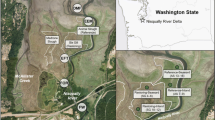Abstract
More than 190 taxa, belonging to 33 genera, were observed on mosses collected on Ile de la Possession, Crozet Archipelago, Antarctica. Six assemblages could be identified. Habitat type and moisture content of the samples appeared to be the major factors in separating the communities. It was clear that diatom communities growing on mosses found in rivers and brooks are different from assemblages on rocks and in stagnant pools. The Diadesmis contenta assemblage was bound to dry mosses growing on rocks whereas the Eunotia paludosa var. paludosa community preferred acid stagnant pools, situated in the larger valleys. The other four assemblages are typical for circumneutral waterbodies, with the Fragilaria maillardii and the Fragilaria vaucheriae-Fragilaria germainii assemblages found in running water and the Fragilaria pinnata var. pinnata and the Achnanthes confusa-Achnanthes aueri assemblages in more stagnant water. Weighted averaging and calibration were used to develop a statistical transfer function to infer the moisture content of moss samples from the diatom assemblages.
Similar content being viewed by others
Author information
Authors and Affiliations
Additional information
Accepted: 29 March 1999
Rights and permissions
About this article
Cite this article
Van de Vijver, B., Beyens, L. Moss diatom communities from Ile de la Possession (Crozet, Subantarctica) and their relationship with moisture. Polar Biol 22, 219–231 (1999). https://doi.org/10.1007/s003000050414
Issue Date:
DOI: https://doi.org/10.1007/s003000050414




